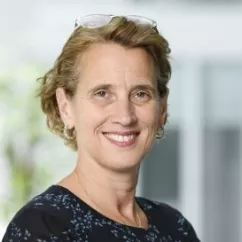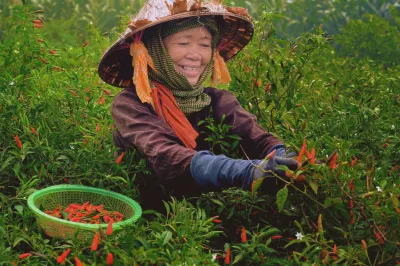FinEquity Interviews Greta Bull

Greta Bull, CEO of CGAP, sat down with FinEquity ahead of International Women's Day to review ways to accelerate progress in women’s financial inclusion and why it matters for improving opportunities and resilience for the poor. CGAP's role as convener of the women’s financial community of practice illustrates its commitment to women's financial inclusion and collective problem-solving.
Women's financial inclusion is a key priority for CGAP as evidenced by CGAP's revised vision statement. What drove that recognition?
We’re trying to refocus our strategy around impact and building meaningful solutions, and you can’t do that without women being front and center. We at CGAP were convinced that gender is a topic that we weren’t paying enough attention to and decided that the only way to advance it was to put it at the top of our priorities so that gender becomes a part of everything we do. We can get into the weeds of technical problems, but we want to be more intentional about how the outcomes we are working towards are improving opportunities and reducing risks for women.
How far have we come in advancing women's financial inclusion, and where do we stand today?
We have made a lot of progress over the last decade. Looking at the Global Findex, between 2014 and 2017, the share of adults globally who have an account rose from 62 percent to 69 percent, and in developing countries from 54 percent to 63 percent. In India, the gap closed significantly, thanks to focused public policy, and in the Philippines, there is actually a reverse gender gap, where women have greater access than men. While we can say women’s financial inclusion has increased, it hasn’t increased faster than for men, and in some countries, it has actually fallen further behind. But for the most part the gender gap seems stubbornly persistent in developing countries, at steady 9 percentage points.
This persistent gender gap is a problem, and it matters because if we want to get to full financial inclusion, we can’t do it with women lagging behind. It’s simple math. Bangladesh advanced a lot between 2014 and 2017, but it was mostly men. If women had advanced at similar rates, we’d have around a 65% inclusion rate, rather the 50% it stands at today. Unless we focus on what it will take for women to be financially included, we are not going to get there.
Also, we don’t have good usage measures broken down by gender. In India, many people have accounts, but we don’t know who is using the accounts or what benefits if any are being derived. I worry it is inclusion on paper and not inclusion in reality.
...what challenges remain?
Well, let’s first start with the positive. The good news is that gender equity is now on everyone’s agenda. That’s a good starting point. Concerns about gender equity and women’s economic empowerment have been around a long time, but it has all too often been a box ticking exercise, where we are simply counting the number of loans to women, or using cheap marketing tricks like a pink credit card to appear we are doing something aimed at women (in the interest of full disclosure, I once had one of those pink credit cards!).
First, we need to shift our approach on measurement. We’ve been so focused on measuring access, we’ve missed that usage gets us closer to meaningful financial inclusion. It’s also about value: do people find value in these services? And how do we define value? Value can be about having a place to park your money safely, making payments conveniently, being able to save where someone can’t take the money from you, and having privacy. Leora Klapper, a lead economist at the World Bank, has done interesting work on women garment workers getting paid through digital means in Bangladesh. Those are empowering because women not only have control over their money, they can avoid long lines to get paid or walk through crowded streets with cash wages, which can pose safety issues. They can also choose to save or use the money. In thinking about how to close the gender gap, it’s not just about giving women accounts, it’s about tackling the value part of the equation. The usage will come if there’s value for women.
From this, we will better understand how the problems differ in various regions. The way women are excluded in Latin America is different from Europe, Africa or South Asia. In the Middle East and North Africa and South Asia, strong social norms mitigate against women’s financial inclusion. While gendered social norms exist everywhere, in some places they are even enshrined in law.
The biggest challenge is the one between our ears: we’re so used to the status quo, we often don’t see where a commonly accepted practice is discriminatory. We see emerging opportunities like gig work and informal online commerce that could really benefit women, but I worry they may also perpetuate existing norms. Let’s look at our own countries and understand where this can take us: there are discussions here about women buckling under the pressure of “having it all”, which means you get the job and work-related stress, but you also get to do a lot of the housework, child rearing, and juggling everything else in our over-complicated modern lives. That really is having it all: all the work! Many professional women are starting to ask questions about what it means to have gender equality. There are a lot of trade-offs women have to make in the modern world that we don’t have easy answers to.
What is CGAP doing?
CGAP convenes FinEquity which brings together 1,300 people from 450 institutions across the globe. That’s a valuable resource for convening, learning, and co-creating around new ways to tackle the gender gap in finance that isn’t just about ticking pink boxes.
Our work on government-to-person payments (or G2P) is being picked up by the World Bank and implemented in multiple markets. It is also very female-friendly as it’s about giving people choice in where and how they can get social payments. We need to explore how those systems might help advance women’s financial inclusion more meaningfully. We’re also looking at how social norms often get in the way of women’s access to, and usage of, financial services. It’s a huge nut to crack.
We’re doing work on emerging, new opportunities for women, including gig platforms and informal online commerce. We’re exploring how these platforms are used and how financial services are leveraged. There seem to be a lot of exciting opportunities emerging for women, but CGAP will be paying very close attention to the risks of these new phenomena. For example, I recently used a gig platform for a service and was surprised to find that the gig worker received less than a third of what I paid to the platform for her time! We get excited about the opportunities of new platforms, but it is important not to ignore the risks that vulnerable people are being exploited. CGAP has learned of instances whereby women engaged in informal online commerce become more home-bound, as their families argue they no longer need to leave the home because they can earn money by staying at home. CGAP’s approach is to first profile and understand how women engage, so we know if something is an opportunity or a risk.
CGAP’s work on agent distribution networks at the last mile also has gender implications. For example, you can’t get women to use the cash-in-cash-out system if there’s a bias against them talking to male agents.
Throughout my career, I have visited MFIs in Latin America, Asia and Africa and have met so many inspiring women entrepreneurs. In Latin America, where I spent many years, a lot of women run microfinance institutions, or they are the heads of branches. Microfinance is a strong example of a female-friendly tool that has done a good job of incorporating responsible financial services and hands-on relationship management. Most of these institutions lend more to women because women are a better credit risk. Sadly, microfinance is a bit out of fashion these days, but there is a lot we can learn from it.
Going forward, a lot more needs to be done to have women’s representation. You go to a central bank and there are no women. The people who are making the rules in the financial sector are men. Women have to have a seat at the table. It’s about power dynamics. As long as women play administrative roles it will be hard to change the current situation. There’s a ton of work to be done to get women seats at the table. It’s about getting women in parliament, women in the judiciary, women in business -- and women in finance.
I wish there was an easy answer, but I don’t think there is. It’s going to be hard work.


